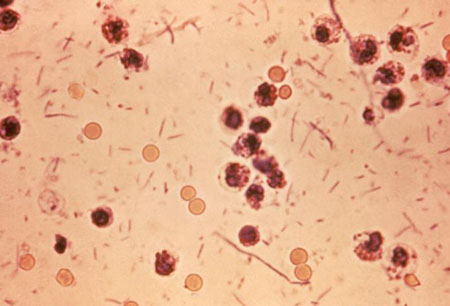Tests
1st tests to order
stool microscopy, culture, and sensitivity
Test
Useful to delineate causes of diarrhea and indicated in suspected shigellosis. A positive result is reportable.[5][13][22][26]
The stool sample is suspended in MacConkey agar to identify non-lactose fermenters such as Shigella species.[5] More selective media are then used, after which slide agglutination with Shigella antisera further indicates the likelihood of shigellosis. Biochemical screening tests are confirmatory for species if non-lactose fermenters are found and thought likely to be Shigella on the basis of selective media cultures and slide agglutination. [Figure caption and citation for the preceding image starts]: Stool exudates in a patient with Shigella infectionCDC [Citation ends].
Result
confirmation of Shigella and sensitivities
serum BUN and creatinine
Test
Volume depletion may be evidenced by rising BUN. Useful to guide fluid resuscitation, along with clinical findings.
Oligo-anuria and acute renal failure are common clinical findings in hemolytic uremic syndrome.
Result
serum BUN may be increased; renal failure suggests hemolytic uremic syndrome
CBC
Test
WBC count may not always be elevated and is nonspecific. However, leukocytosis may be indicative of septicemia in severe presentations.
Volume depletion may be evident with rising hematocrit.
Anemia due to nonimmune-mediated hemolysis and thrombocytopenia are features of hemolytic uremic syndrome.
Result
occasional leukocytosis; possible high hematocrit; thrombocytopenia and anemia suggest hemolytic uremic syndrome
Tests to consider
Shigella serotyping
peripheral blood smear
Test
Used along with clinical findings to detect hemolytic uremic syndrome.
Result
usually normal; presence of fragmentocytes suggests hemolytic uremic syndrome
abdominal x-ray
Test
Ordered if toxic dilation or severe colitic process secondary to severe shigellosis is suspected.[26]
Although rare, intestinal necrosis and pancreatic involvement may be seen with hemolytic uremic syndrome.
Result
markedly dilated colon suggests toxic colon or severe colitis
flexible sigmoidoscopy
Test
Not often required. May be useful to exclude strongly suspected idiopathic inflammatory bowel disease.[26]
Result
normal; ulcers suggest ulcerative colitis
Use of this content is subject to our disclaimer